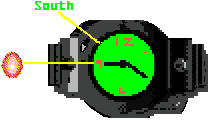
Without a Compass

Without a Compass
To be accurate with this method, you have to understand its limitations and assumptions.
High Noon is the time half-way between sunrise and sunset. Within the eastern time zone, High Noon is 12:30 PM. This is when the sun reaches its highest elevation in the sky. During Daylight Savings Time, High Noon will be at 1:30 PM.
The illustration represents the Eastern time zone, Daylight savings time.
The hour hand is pointing at 9AM.

Duh, I just remembered, my watch is digital! You know the hour, right? Just draw a clock face on the ground, with the hour pointing towards the sun, or use method two.
Ok, you got your watch, you know the time. The sun travels across the sky
east to west, in a curved path, one degree every four minutes. Where it
reaches it's highest point, that's South (in the Northern Hemisphere).
So, your watch says 2:24PM. That means the sun has traveled past noon 144
minutes. Four divided into 144 equals 36, the amount of degrees the sun has
traveled past its high point.
Great, I got the math, but how do I measure the degrees?
Use the Hand method. Extend your arm full forward. Spread your fingers,
thumb extended. The spread, from the end of your thumb, to the outside edge
of your little finger, is about 22 degrees (figure 1). Making your hand into
a fist, it's 8 degrees, with degrees between the knuckles, as figure 2. Use
these degree guides to measure back the number of degrees to sun noon. Do
this in a arc, (figure 3) just as the sun travels. You can of couse, check
these degrees of your hand, with a compass, before you go out in the field.
All these measurements are approximate, they should put you within 4-6
degress of true north.
 |
 |
 |
Now it's night, no sun! One night method to use doesn't require knowledge of were to find the Big Dipper, or the north star, Polaris. Just use two sticks to sight on any star, as per the figure below.

If your moving at night, pick a star on the horizon. Keep it equi-distant from you, at the same level on the horizon. This will help to travel in a straight line.
When you're finished with this section, |